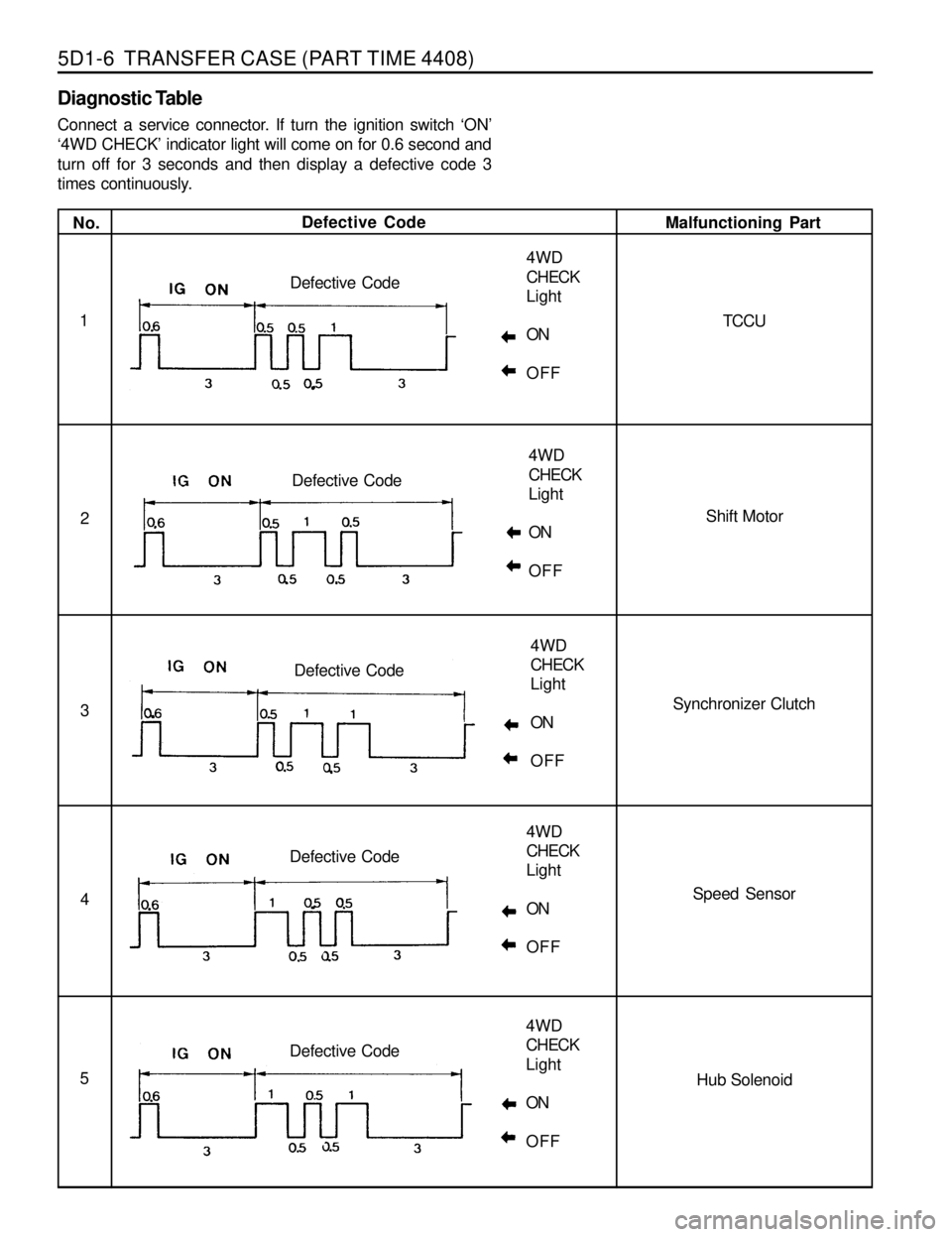1998 SSANGYONG MUSSO light
[x] Cancel search: lightPage 1013 of 1463

5A-36 AUTOMATIC TRANSMISSION
4-3 Sequence Valve
The 4-3 sequence valve (refer figure 3.14) is a two position spring loaded valve. It switches during 3-4 and 4-3
gearshifts although it performs no function during the 3-4 shift.
During the 4-3 shift the 4-3 sequence valve delays the connection of the clutch apply feed circuit (CAF) to the BIR
circuit until the BIR circuit has been fully pressurised by using the third gear circuit. This prevents objectionable
engine flare on completion of the 4-3 gearshift.
Figure 3.14 - 4-3 Sequence Valve
Figure 3.15 - Solenoid Supply Pressure Regulator Valve and Line Pressure Control Valve
Solenoid Supply Pressure Regulator Valve
The solenoid supply valve (refer figure 3.15) supplies a constant pressure to all solenoids (51 to 57). Line pressure
is used as the feed oil to this regulator and the output is termed line 500.
Line Pressure Boost Valve
Line pressure is controlled by 56, which acts as the line pressure boost valve (refer figure 3.15). When 56 pressure
is applied to the end of the PRV it is opposed by spring force and causes LOW line pressure for light throttle
application and cruising.
Heavy throttle application causes the normally open 56 to open (switch Off) thus closing line 500 and opening 56 to
exhaust. Removal of 56 pressure from the PRV results in HIGH line pressure.
Page 1016 of 1463

AUTOMATIC TRANSMISSION 5A-39
Primary Regulator Valve
The primary regulator valve (PRV) (refer to figure 3.19) regulates the transmission line pressure (or pump output
pressure). This valve gives either high or low line pressure depending on whether S6 is switched Off or On, When S6
is switched On,S6 pressure is applied to the PRV moving it against spring pressure and opening the line pressure
circuit to the pump suction port resulting in reduced line pressure. Low line pressure is used during light throttle
applications and cruising. Heavy throttle will cause S6 to switch Off and thereby cause high line pressure.
This stepped line pressure control has no detrimental effect on shift feel because all shifting pressures are controlled
by separate band and clutch regulator valves, and the output of S5.
When reverse gear is selected, both the low and high line pressure values are boosted to guard against slippage.
This is achieved by applying reverse oil line pressure to the PRV to assist the spring load. The other end of the valve
contains ports for line pressure feedback and 56 pressure.
The PRV also regulates the supply of oil to the converter via the converter feed port. The cascade effect of the PRV
ensures the first priority of the valve is to maintain line pressure at very low engine speeds. When the engine speed
increases and the pump supplies an excess of oil the PRV moves to uncover the converter feed port thereby pressurising
the converter. If there is an excess of oil for the transmission’s needs then the PRV moves further to allow oil to return
to the suction port.
Figure 3.19 - Primary Regulator Valve
Page 1051 of 1463

5A-74 AUTOMATIC TRANSMISSION
Action
Inspect, repair C2 and adjust the linkage as neces-
sary.
Repair C2. Inspect, repair or replace S6 as neces-
sary.
Repair C2. Inspect, replace the sealing rings and/
or shaft as necessary.
Repair C2. Inspect, repair or replace the C2 piston
as necessary.
Inspect C4 and repair as necessary.
Inspect and adjust the C4 pack clearance as nec-
essary.
Repair C4. Inspect and replace the wave plate as
necessary.
Repair C4. Inspect and realign the wave plate as
necessary.
Repair C4. Inspect and realign the sealing rings
and/or shaft as necessary.
Repair C4. Inspect and refit the OWC as neces-
sary.
Repair C4. Inspect and replace the C2 piston as
necessary.
Repair C4. Inspect and refit the ball as necessary.
Inspect and repair B1 and replace the spring as
necessary.
Replace sealing ring.
Repair B1. Refit the ball as necessary.
Inspect and repair C1 and replace the spring.
Repair C1. Inspect and replace the sealing tongs
and/or shaft as necessary.
Repair C1. Inspect and replace the C1 piston as
necessary.
Repair C1. Inspect and refit the capsule as neces-
sary.
Repair C1. Inspect and refit the valve as neces-
sary.
Repair C1. Inspect and replace the ball as neces-
sary.
Inspect and adjust the band as necessary.
Inspect and refit the ball as necessary.
Inspect and replace the ‘O’ ring as necessary.
Inspect and refit the valve as necessary.
Inspect and replace the ‘O’ ring as necessary.
Inspect and refit the valve as necessary.
Possible Cause
T-bar linkage out of adjustment.
56 foiled - stuck low.
Overdrive/output shaft sealing rings damaged.
C2 piston cracked.
Incorrect C4 pack clearance.
C4 wave plate broken.
C4 wave plate not lined up properly.
Overdrive or output shaft sealing rings dam-
aged.
3-4 one way clutch (OWC) in backwards.
C2 piston cracked.
Over-run clutch (OC)/low-1st ball misplaced.
B1R spring broken.
Input shaft sealing ring cut.
C1/B1R ball misplaced.
B1R spring left out.
Overdrive or input shaft sealing rings damaged.
C1 piston cracked.
Ball capsule jammed.
4-3 sequence valve in backwards.
Clutch apply feed (CAF)/B1R ball left out.
Rear band incorrectly adjusted or damaged.
Reverse-low/first ball misplaced.
Input shaft ‘O’ ring missing or damaged.
Converter clutch regulator valve in backwards.
Input shaft ‘O’ ring missing or damaged.
C1 bias valve in backwards.
Symptom
C2 burnt
C4 burnt
B1 burnt
C1 burnt
Slips in reverse -
no manual 1st
Firm converter
lock or unlock
No lock up at light
throttle
Table 6.2.4 - After Teardown Faults
Page 1057 of 1463

5A-80 AUTOMATIC TRANSMISSION
6. Switch off the engine and raise the vehicle on the hoist, if applicable, ensuring that the vehicle is level.
7. Three minutes after the engine has stopped, but no longer than one hour, remove the filler pump, The correct
level is reached when ATF is aligned with the bottom of the filler hole. If the correct level is not reached, then add
a small quantity of ATF to the correct level.
8. Replace the transmission filler plug and clean all remnants of ATF on the transmission and vehicle.
9. Tighten the transmission filler plug to specification.
Checking, Adding Fluid and Filling - Drained or Dry Transmission
To set the correct fluid level proceed as follows.
1. Set the transmission selector to Park and switch the engine off.
2. Raise the vehicle on a hoist (or leave over a service pit).
3. Clean all dirt from around the service fill plug prior to removing the plug, Remove the oil service fill plug. Clean the
fill plug and check that there is no damage to the ‘O’ ring. Install the filler pump into the filler hole.
4. Lower the vehicle with the filler pump still connected and partially fill the transmission. This typically requires
approximately :
a. If the transmission torque converter is empty:
9.0 litres - 4WD
9.0 litres - RWD
b. If the transmission torque converter is full:
4.5 litres - 4WD
4.5 litres - RWD
5. Start the vehicle in Park with the Parking brake and foot brake applied with the engine idling, cycle the transmission
gear selector through all positions, adding ATF until gear application is felt.
6. Then add an additional 0.5 litres of ATF.
7. Switch off the engine and raise the vehicle on the hoist. Remove the filler pump and replace the filler plug. The
plug shall be tightened to specification.
8. The vehicle is then to be driven between 3.5 and 4.5 kilometers at light throttle so that the engine does not
exceed 2500 rpm. This should result in the transmission temperature being in the range 50 to 60°C.
9. With the engine idling, cycle the transmission selector through all gear positions with the brake applied.
10. Stop the engine. Raise the vehicle on the hoist, if applicable ensuring the vehicle is level.
11. Three minutes after the engine has stopped, but no longer than one hour, remove the filler plug. The correct
level is reached when ATF is aligned with the bottom of the filler hole. If the correct level is not reached, then add
a small quantity of ATP to the correct level.
12. Replace the transmission filler plug and clean all remnants of ATF on the transmission and vehicle. Tighten the
transmission Filler plug to specification.
ELECTRONIC ADJUSTMENTS
Idle Speed Adjustment
Carry out the adjustments to the idle speed as detailed in the workshop manual.
Throttle Position Calibration
Should the throttle position data stored in the TCU be lost or be out of specification, as indicated by a diagnostic
trouble message, it may be re-established by the following procedure.
lCheck that the hot engine idle speed is within specification.
lAllow the engine to idle in ‘Drive’ for 60 seconds with the air conditioner (if fitted) turned off. The closed throttle
reference point in the TCU has now been set.
Switch the engine off but leave the ignition on. Hold the accelerator pedal on the floor for 60 seconds. The wide open
throttle reference point in the TCU has now been set.
Page 1141 of 1463

5B-34 MANUAL TRANSMISSION
COUNTER SHAFT
Disassembly Procedure
1. Using a hydraulic press and special tool, remove the front
bearing assembly from the counter shaft.
2. Check and clean all removed parts and replace if necessary.
Assembly Procedure
1. Using a hydraulic press and installer, press the front bearing
assembly onto the counter shaft.
2. Install is as follows :
lInstall a new O-ring on the counter shaft outer race and
lubricate it.
lUsing a installer, lightly tap the race into its bore until the
O-ring is compressed.
lInstall the race to be fully seated on the inside of the
case.
Page 1174 of 1463

5D1-4 TRANSFER CASE (PART TIME 4408)
SELF-DIAGNOSIS
SYSTEM DESCRIPTION
1. TCCU detects transfer case system malfunctions and
indicates malfunctioning part(s) through flashing 4H,4L
indicator lights.
Using a service connector, connect it to the diagnosis box
in the engine room and read the flashing of the ‘4WD
CHECK’ indicator light.
The flashing indicator light will show you defective code(s).
2. Identify 7 defective codes after reading the flashing indicator
light.
lTCCU
lShift motor
lMagnetic synchronizer clutch
lSpeed sensor
lHub solenoid
lSelector switch
lMotor position sensor
3. Transfer case system is malfunctioning when:
l4H ,4L indicator lights are remain on after 0.6 second
when turning the ignition switch ‘ON’
l4H,4L indicator lights are continuously come on during
driving.
4. If only 1 part is malfunctioning, ‘4WD CHECK’ indicator light
will display defective code 3 times continuously.
5. If more then 2 part is malfunctioning, the first malfunctioning
part will be displayed 3 times and following malfunctioning
parts will be displayed .
6. To read defective code, connect the service connector and
turn the ignition switch 'ON'.
7. After repairing, eliminate the defective code stored in the
TCCU.
Notice
Before replacing the malfunction parts with defective code,
check the wires and connectors for proper condition.
Page 1175 of 1463

TRANSFER CASE (PART TIME 4408) 5D1-5
Defective Code Reading
1. Position the ignition switch to ‘OFF’
2. Using a service connector, connect the No.2 pin ( lgnition )
and No.6 pin (TCCU) of the diagnosis socket in the engine
room.
3. Position the ignition switch to 'ON'.
4. Read the flashing ‘4WD CHECK’ indicator light and identify
the malfunctioning part.
How to Eliminate the Falut Code
1. Position the ignition switch to ‘OFF’
2. Using a service connector, connect the No.2 pin (GND) and
No.6 pin (TCCU) of the diagnosis socket in the engine room.
3. Position the ignition switch to ‘ON’ over 5 seconds.
4. Do defective code reading and make sure that all defective
codes are eliminated.
Page 1176 of 1463

5D1-6 TRANSFER CASE (PART TIME 4408)
Diagnostic Table
Connect a service connector. If turn the ignition switch ‘ON’
‘4WD CHECK’ indicator light will come on for 0.6 second and
turn off for 3 seconds and then display a defective code 3
times continuously.
No.Defective Code
Malfunctioning Part
1
2
3
4
5TCCU
Shift Motor
Synchronizer Clutch
Speed Sensor
Hub Solenoid
4WD
CHECK
Light
ON
OFF
Defective Code
4WD
CHECK
Light
ON
OFF
Defective Code
4WD
CHECK
Light
ON
OFF
Defective Code
4WD
CHECK
Light
ON
OFF
Defective Code
4WD
CHECK
Light
ON
OFF
Defective Code